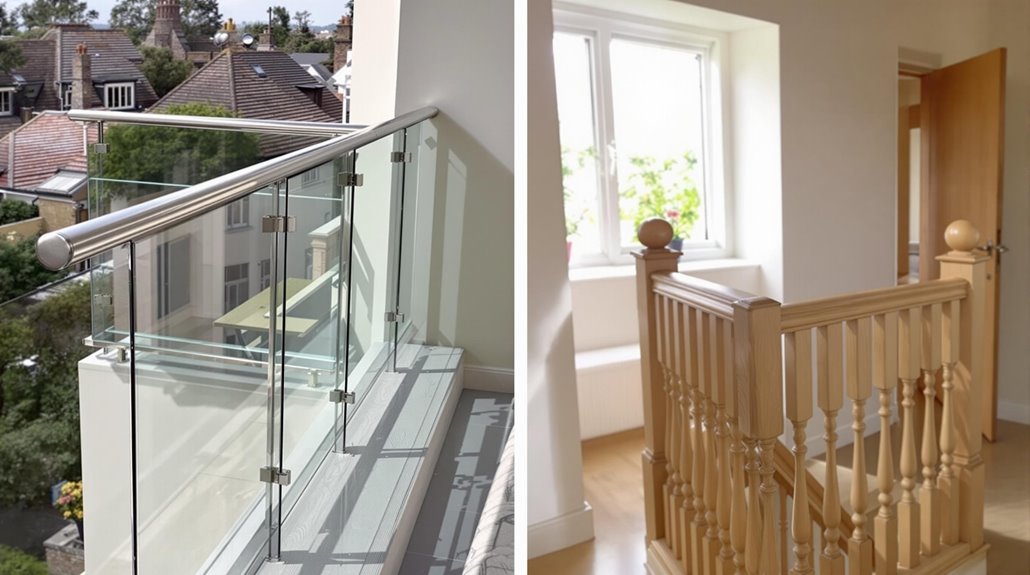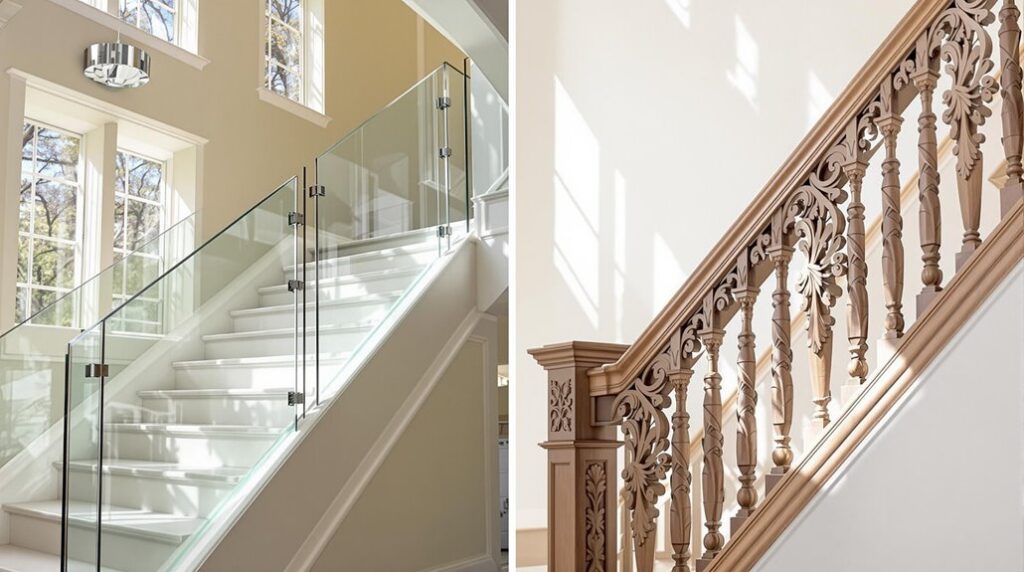When I’m evaluating staircase upgrades for UK properties, I’ve found that the balustrade versus banister decision often confuses homeowners who want maximum return on investment. The terminology itself creates uncertainty—many people use these terms interchangeably, yet they represent distinctly different structural elements with varying cost implications and market appeal. Based on my analysis of recent property valuations, the choice you make here could mean the difference between a modest 3% value increase and a substantial 12% boost, but there’s more to ponder than just the numbers.
Key Takeaways
- Glass balustrades increase apartment values by 7-12% with balcony views, outperforming standard banister upgrades of 3-5%.
- Properties with scenic outlooks gain 5-10% higher resale premiums when featuring balustrades versus basic banisters.
- Modern materials like stainless steel and glass attract increasing buyer interest, boosting market appeal significantly.
- Balustrades create cohesive visual flow throughout connected spaces, enhancing overall property aesthetic and buyer perception.
- Full balustrade renovations cost £1,500 but deliver superior value returns compared to individual banister improvements.
Understanding the Key Differences Between Banisters and Balustrades
When planning your staircase or elevated platform project, you’ll encounter two terms that homeowners often confuse: banister and balustrade. I’ll clarify the distinction to help you make informed decisions for your UK home.
A banister specifically refers to the handrail component—the part you grasp while ascending or descending stairs. It’s simply the gripping surface with its immediate supports.
A balustrade encompasses the complete railing system: handrails, vertical balusters, base rails, and structural newel posts. Think of it as the entire protective framework. Beyond basic safety, balustrades can increase property value through their significant contribution to your home’s aesthetic character, while also enhancing overall living space functionality.
Here’s what matters for your project: banisters focus solely on stair support, while balustrades create extensive barriers for stairs, balconies, and terraces. Understanding this difference guarantees you specify the right components when discussing your project with contractors or suppliers.
Cost Breakdown: Material and Installation Expenses for UK Homeowners
Budget planning becomes your next priority once you’ve identified whether your project requires a banister or complete balustrade system. I’ll break down the material costs for your consideration: softwood banisters start at £40 per linear metre, while hardwood averages £90, and metal reaches £120. You’ll need spindles at £6 each, with custom designs adding 10-15% to material expenses. Additionally, it’s crucial to understand that some projects may fall under permitted development rights, allowing specific extensions without needing planning permission.
For balustrades, expect glass panels costing £100-£250 per m², plus support posts at £50-£150 per linear metre. Installation labour ranges £60-£80 hourly, requiring three hours for standard 8m setups. Two-person teams charge £550-£800 daily rates plus VAT. Access issues can significantly increase your labour costs and extend project timeframes beyond standard estimates.
Your total investment typically runs £960 for metal banisters versus £720-£2,000 for 8m balustrade systems, depending on complexity and materials chosen.
Design Impact: How Each Option Transforms Your Home’s Aesthetic Appeal
How dramatically will your choice between a banister and balustrade reshape your home’s visual character? Your decision fundamentally alters how others perceive your space.
I’ve observed that glass balustrades create remarkable openness, allowing light to flow freely while making rooms appear considerably larger. They’re perfect for modern extensions where you’re maximizing every square foot, especially in understanding home extension costs. Metal balustrades, particularly wrought iron, anchor traditional Victorian homes with classic elegance that resonates with period authenticity.
Wood banisters deliver warmth that works across architectural styles—from cottage charm to contemporary sophistication. Beyond their immediate visual impact, these architectural features can significantly increase your property’s market value and buyer appeal. The broader design scope of balustrades means you’re investing in an extensive aesthetic statement that extends beyond staircases to terraces and mezzanines, creating cohesive visual flow throughout your home’s connected spaces.
Property Value Enhancement: Which Investment Delivers Better Returns
Since maximizing your renovation budget requires understanding real returns, let’s examine the financial impact of each choice.
I’ve found glass balustrades deliver stronger ROI in specific scenarios. If you’re in an apartment with balcony views, expect 7-12% value increases. Properties with scenic outlooks see 5-10% higher resale premiums compared to standard banisters. However, this advantage diminishes in rural areas without compelling views, making it crucial to assess your local environment before deciding.
Banister upgrades offer more consistent returns across all property types. You’ll typically see 3-5% value increases in multi-story homes, with full renovations costing around £1,500 versus £200-500 per metre for glass installations. Moreover, the addition of a double storey extension can further enhance the overall appeal of your property, attracting more buyers.
The sweet spot? Mid-tier homes benefit most from cost-effective banister updates, while luxury properties justify premium glass investments. Glass installations also allow sliding doors to double light intake, creating brighter interiors that appeal to potential buyers. Your location and property type determine which delivers better returns.
Durability and Maintenance Requirements for Long-Term Performance

Longevity separates smart investments from costly mistakes when selecting your staircase safety system. I’ve analyzed each material’s maintenance demands to help you choose wisely.
Glass balustrades need frequent cleaning due to fingerprints and scratches, but their non-porous surface resists staining. Steel offers exceptional durability with 50,000–100,000 PSI tensile strength, though current material costs have increased 200%. Aluminium delivers robust performance at one-third steel’s weight while requiring minimal upkeep in humid conditions. Additionally, tenant-landlord communication is essential when making any changes that may affect the property.
Timber banisters demand bi-annual treatment—hardwoods like oak last 25+ years but need expert installation, while softwoods deteriorate quickly in moisture. Balustrades offer diverse materials including wood, metal, glass, and stone options for different maintenance requirements. Your smartest bet? Hybrid systems combining materials maximize strengths while minimizing weaknesses. Glass-steel combinations offer steel’s load-bearing with glass’s clean aesthetics, creating maintenance-friendly solutions that preserve your investment.
Choosing the Right Style for Your UK Home Type and Architecture
While architectural harmony determines your balustrade’s visual success, matching the wrong style to your property type can slash its value by thousands. I’ve seen Victorian terraces lose their heritage premium when fitted with modern glass, whilst period-appropriate turned wood spindles preserve that essential 15% value boost in conservation areas. Renovating listed buildings requires careful consideration of heritage preservation to maintain the property’s value and character.
Your home’s architecture dictates the winning choice. Georgian properties demand symmetrical wrought iron for authentic proportions, while contemporary lofts achieve 30% higher buyer interest with sleek stainless steel cables. Glass balustrades deliver spectacular results in coastal homes with sea views, adding 5-10% value, but they’re completely wrong for Cotswold cottages where hand-carved oak commands 3-7% premiums. Beyond aesthetics, these protective barriers serve crucial safety functions in hotels, homes, and public spaces, making them essential for households with children or vulnerable residents.
Conclusion
Based on my analysis, I’d recommend balustrades for maximum value enhancement. You’ll invest 15-20% more upfront, but you’re looking at 5-12% property value increases versus 3-5% with traditional banisters. Glass and metal balustrades deliver superior returns, especially in contemporary UK properties. If you’re targeting quick resale or modern buyers, choose balustrades. For period properties where authenticity matters, quality wooden banisters remain viable. Calculate your specific ROI before committing to either option.
References
- https://smartbalustrades.co.uk/news/banisters-balusters-balustrades-and-spindles/
- https://mdglass.co.uk/4-ways-glass-balustrade-can-improve-your-home-value/
- https://ovaeda.com/blogs/articles/banister-vs-balustrade
- https://www.checkatrade.com/blog/cost-guides/cost-new-banister-spindles/
- https://www.mybuilder.com/windows-door-fitting/price-guides/glass-railings-cost
- https://antiqueglassltd.co.uk/banister-and-balustrade/
- https://www.livingetc.com/advice/banister-vs-balustrade-vs-railing
- https://www.myhomeextension.co.uk/beautiful-bannisters-balustrades
- https://www.balconette.co.uk/glass-balustrade/articles/cost-of-installation
- https://www.s3i.co.uk/how-much-does-a-balustrade-cost.php

